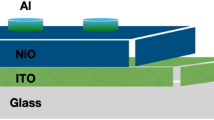Abstract
Hole capture data obtained by capacitance transient spectroscopy on eleven different acceptors in high-purity germanium are presented over the temperature range 8–160 K. Capture invariably proceeded faster than predicted by the cascade theory and did not follow theZ 3 T −3 dependence predicted by cascade theory, whereZ is the acceptor charge andT is the temperature. Instead it was found that capture followed the phenomenological relationship
whereN υ is the effective density of states at the valence band edge,g is the degeneracy of the ground state (four),p is the hole concentration,τ c is the mean capture time for the acceptor,k is Boltzman’s constant, andh is Planck’s constant.η is a dimensionless efficiency factor and exp (—E α /kT) is an activation term required to fit the data of some centers. The authors propose that transitions to the electronic ground state from band states or from bound excited states must be faster than previously considered.
Similar content being viewed by others
References
M. Lax, Phys. Rev. 119, 1502 (1960).
V. N. Abakumov, V. I. Perel, and I. N. Yassievich,Sov. Phys. Semicond. 12, 1 (1978).
See for example, M. Jaros, Deep Levels in Semiconductors, Adam Hilger LTD, Bristol (1982).
L. S. Darken and G. E. Jellison, Jr., Appl. Phys. Lett. 55, 1424 (1989).
We could not distinguish among hydrogenic acceptors, so there is a possibility that one or more of these acceptor levels might be −110(1) with aA-/A° level which is hydrogenic.
E. E. Haller, G. S. Hubbard, W. L. Hansen, and A. Seeger: Proc. 9th Int. Conf. Radiation Effects in Semiconductors, Dubrovnik, Yugoslavia, 1976 (Inst. Phys. Conf. Ser. No. 31, Bristol, 1977), p. 309.
R. N. Hall: Proc. 13th Int. Conf. Defects in Semiconductors, Coronado, USA, 1984 (The Metallurgical Society of AIME, New York, 1985) p. 759.
A. O. Evwaraye, R. N. Hall, and T. J. Soltys, IEE Trans. Nucl. Sci. NS-26, No. 1, 271 (1979).
E. E. Haller, P. P. Li, G. S. Hubbard, and W. L. Hansen, IEE Trans. Nucl. Sci. NS-26, No. 1, 265 (1979).
E. Simoen, P. Clauws, J. Broeckx, J. Vennik, M. van Sande, and L. De Laet,IEEE Trans. on Nucl. Sci. NS-29, No. 1, 789 (1982).
A. F. Neumark and K. Kosai, p. 1 in Semiconductors and Semimetals, Vol.19, ed. by R. K. Willardson and A. C. Beer, Academic Press Inc., New York, 1983.
D. V. Lang and C. H. Henry, Phys. Rev. Lett. 35, 1525 (1975).
Author information
Authors and Affiliations
Rights and permissions
About this article
Cite this article
Darken, L.S., Sangsingkeow, P. & Jellison, G.E. Hole capture at acceptors inp-type germanium. J. Electron. Mater. 19, 105–110 (1990). https://doi.org/10.1007/BF02655557
Received:
Issue Date:
DOI: https://doi.org/10.1007/BF02655557




